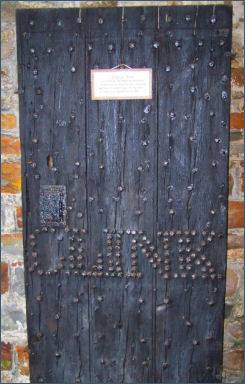Stratton
OS Grid ref:- SS 2306
 The small, historic town of Stratton is situated near the outskirts of the coastal resort of Bude in north Cornwall.
The small, historic town of Stratton is situated near the outskirts of the coastal resort of Bude in north Cornwall.
Known in Cornish as Strasnedh, Stratton is of ancient origin, the earliest recorded mention of the town is found in the will of the Anglo-Saxon King Alfred the Great (849 – 899), it is also referred to in the Domesday Book of 1086. Before the Norman conquest the manor had been held by Bishop Osbern and Alfred the Marshal. The earliest form of the town's name is as Strętneat, an Anglo-Saxon derivation of the Old Cornish "strad" and "neth", meaning the flat-bottomed valley of the river Neth.
 The town had a thriving leather and agricultural trade during medieval times. Stratton also housed tanning pits and a rack park, where the leather was stretched.
The town had a thriving leather and agricultural trade during medieval times. Stratton also housed tanning pits and a rack park, where the leather was stretched.
The historic Tree Inn in Fore Strret (pictured left) was once the Elizabethan manor house of the influential Grenville family and was also the birthplace of the Cornish Giant, Antony Payne. The courtyard is a sun trap and a great place for a Saturday pub lunch while on Sundays in the gallery or the barn bar a carvery is served. The Kings Arms, a seventeenth century coaching inn, also serves good home made food and displays prints of the surrounding area in the lounge bar, all with an interesting narrative.
During the Civil War Stratton made its mark in history as the stronghold of King Charles I and the Royalists, when Sir Bevil Grenville commanded the King's army in the victorious battle at nearby Stamford Hill on 16 May 1643.
 The Parliamentarian army commanded by the Earl of Stamford, were camped in and around Stratton with 5400 foot soldiers and 200 horsemen having arrived from Exeter to cut off the Royalist army under Sir Ralph Hopton and prevent their march north. The Royalists included the Cornish men of Sir Beville Grenville and Antony Payne The fighting lasted all day until a final charge up Stamford Hill by the Cornish army caused the enemy to flee leaving 300 dead and 1700 prisoners including the Parliamentarian commander, Major-General James Chudleigh. Hopton's victory temporarily secured Cornwall for King Charles I.
The Parliamentarian army commanded by the Earl of Stamford, were camped in and around Stratton with 5400 foot soldiers and 200 horsemen having arrived from Exeter to cut off the Royalist army under Sir Ralph Hopton and prevent their march north. The Royalists included the Cornish men of Sir Beville Grenville and Antony Payne The fighting lasted all day until a final charge up Stamford Hill by the Cornish army caused the enemy to flee leaving 300 dead and 1700 prisoners including the Parliamentarian commander, Major-General James Chudleigh. Hopton's victory temporarily secured Cornwall for King Charles I.
The town's Anglican church is dedicated to Saint Andrew is an ancient building in the early English and perpendicular styles. The Grade I listed building contains a sixteenth century black marble tomb with a brass to Sir John Arundell of Trerice (pictured left), a commander of the Royal Navy at the time of King Henry VIII and Edward VI and twice High Sheriff of Cornwall who died in 1561. The tomb is situated against the west wall of the church, Sir John is depicted between his two successive wives, Mary Arundell and Juliana Erisey and thirteen of his children.
In the north aisle is the effigy of a Knight Templar, supposed to be that of Ranulph de Blanchminster, constable of Ennour Castle, in Scilly, Sir Ranulph lived at Bynaway in Stratton during the reign of Edward I and is said to have gone on Crusade with Edward before he became king. The Royal Arms of King Charles II are also displayed in the church, at the restoration of the monarchy under Charles II similar Arms were put up in many Cornish churches.
The door of the long demolished old town jail, is marked "CLINK" in heavy studs, and is still kept in the church porch. St. Andrew's was restored in 1888 by James Piers St Aubyn and Henry J. Wadling.
Antony Payne, 'the Cornish Giant'
 Antony Payne, the Cornish giant, was born in the Manor House at Stratton, which is now the Tree Inn.
Antony Payne, the Cornish giant, was born in the Manor House at Stratton, which is now the Tree Inn.
Standing at seven feet four inches and at his heaviest weighing 38 stones, Payne's father had been a tennant farmer of the Grenville's and when Antony was 21 he was taken into the Grenville household as a steward and later was enlisted as a bodyguard to the Royalist commander, Sir Bevil Grenville.
He fought beside Sir Bevil, who commanded King Charles I's Royalist army in the victorious battle at nearby Stamford Hill in 1643. A trusted aide, he also educated Grenville's sons in the country pursuits of hunting fishing and shooting and how to "handle arms".
For all his size and bulk, the witty Payne showed no signs of clumsiness, but awed everyone with his dexterity and very quick reflexes. He later served Sir Bevil's son Sir Richard Grenville at the Plymouth garrison where his portrait was painted by Sir Godfrey Kneller.
Payne lived and died in the Grenville manor house at Stratton, it is claimed that, when the giant died in 1691 at the age of 81, the house had to be restructured to allow his huge coffin to be carried in and out. He was buried at St. Andrew's Church in an unmarked grave.
A portrait of Anthony Payne, hangs in the court yard of the Tree Inn, which is a reproduction of the one that is in the Cornwall Gallery Museum by Sir Godfrey Kneller.